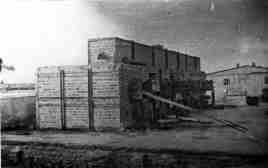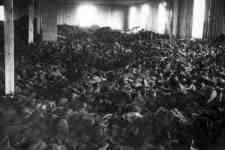The combined concentration- and extermination camp Majdanek was built in
August/September 1941.
 |
| Air Photo |
 |
| 1942 Camp Map |
Ordered by
Heinrich Himmler, the camp was built by the
Zentralbauleitung der SS und Polizei under the command of
Odilo Globocnik, the
SS- und Polizeiführer des
Distrikts Lublin.
At first a concentration camp should be built near the cemetery at
Lipowa Street.
In the
summer of 1941 Jewish POWs from the
Lipowa Camp started to prepare the territory
south west of the cemetery. Because the German civil administration was against these plans,
Globocnik decided to build the concentration camp outside
Lublin, on the
Dziesiata Fields. When the
camp was already under construction, the name was changed into more popular "Majdanek" (from the name of the suburb
Majdan Tatarski). The camp administration was located at
Gartenstraße 12.
 |
| Postcard from Majdanek |
 |
| Postcard to Majdanek |
Until April 1943 the camp was named "POW camp of the Waffen-SS Lublin" but
already in
November/December 1941 first groups of prisoners (not only the Soviet POWs)
were sent there, among them a group of 200 Jews from the
Lublin Ghetto, groups of Jews from the small towns around
Lublin and Polish peasants from the
Lublin
district.
The next group (2,000-2,500 people) of the Jewish Lubliners was sent on
24 April 1942
from the small ghetto at
Majdan Tatarski (this ghetto was established
after the liquidation of the big ghetto and was located close to the
old airfield).
From this group only 120-200 young men were selected for work. All others (mostly women, children and old people)
were executed at
Krepiec Forest, 11 km from Majdanek.
Here the Nazis carried out the mass executions of the Majdanek prisoners and Jews from
Majdan Tatarski, until the construction of the gas chambers at the camp
site was finished. From
early 1943, the victims were cremated at
Krepiec Forest on pyres.
 |
| Gas Chambers |
 |
| Workshops in July 1942 |
The camp was located only 3 km south of the
Lublin centre. Today the camp
site is part of the city, at the road to
Zamosc.
With 2.7 km
2 it was even larger than
Auschwitz-Birkenau.
Majdanek should become the largest concentration camp outside the German
Reich.
In the centre of the camp ten fields were planned, surrounded by electric barbed wire and watchtowers.
Each field should contain 20 barracks for prisoners and two barracks for necessary equipment.
In three gas chambers the people were gassed mostly by carbon-monoxide (this information is from
the camp undergound reports which are kept at the museal archive). The victims' belongings were sold,
their
hair too!
The bodies were burned in a crematory. Forced labourers worked in about 20 barracks
(workshops and storerooms) and outside the camp.
 |
| Hill of Ashes - First Memorial |
 |
| Burned Crematory |
Prisoners who didn't die by starvation, exhaustion or illness often were hanged, shot or gassed.
The biggest mass murder in Majdanek happened on
3 November 1943. In course of the
"
Aktion Erntefest" 16,000-18,000 Jews were shot this day.
See the
Commemorative Plaque!
In
July 1944, the camp was evacuated because of the advancing Red Army.
It was originally estimated that during its existence about 300,000 prisoners (more than 50% of whom were Jews) passed through the camp,
and that approximately 78,000 of them died. More recent research indicates that the total number actually deported to the camp
was in the region of 100,000 - 120,000, although a definitive figure is yet to established.
Resistance organisations were active during the camp's existence. A few prisoners could escape and informed
others about the structures and conditions in the camp. The report of a Slovakian Jew is kept in the Majdanek
archive. He escaped from the camp together with another inmate. They bore witness to their fellow Jews in Hungary
and Slovakia.
See a rare
document, drawn by a fugitive. He (she?) knew the location of the
prisoners' field and the storerooms very well. The gas chamber is not correctly placed, perhaps because it was not
yet built. Therefore the fugitive must have escaped before
October 1942.
Since
1944 the former camp site is a
memorial.
Today the visitor can still see the workshop barracks, two gas chamber buildings, the crematory,
some prisoners barracks and a few remainings of SS buildings.

|

|

|

|
| CO Gas Cylinders |
Chimney |
Gas Chamber Door |
Shoes |
Photos: Majdanek Memorial Archive.




















